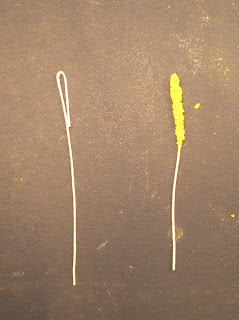
- The stamens. Make 6. Cut six 3" pieces of #32 white covered wire. Bend the wire over about 3/4" as shown in the photo below. Moisten this part with egg white or gum glue and dip in something like corn meal to resemble pollen. (I used a mixture of gelatin powder and yellow petal dust.) Let dry.

- The pistil. Cut a length of #18 covered wire. This will be the actual stem of the tulip. Colour some gum paste a very light green. Moisten the end of the wire and work the paste to cover the top 2 1/2" of the wire. Pinch the top of the paste into three, as in the photo. Leave upright to dry.
 This photo is of my oval cutter and the pistil.
This photo is of my oval cutter and the pistil.
- Petals. Make 6, three should be slightly narrower. Colour some gumpaste the shade you want your tulips. Roll out thinly on a grooved board
 Turn paste over and cut out petal. Moisten the end of a 4" length of #28 covered wire and push into the raised portion of the petal.
Turn paste over and cut out petal. Moisten the end of a 4" length of #28 covered wire and push into the raised portion of the petal.  Tool the petal to thin out the top edge.
Tool the petal to thin out the top edge. Vein each petal. I have an Aldeval tulip veiner which works well.
Vein each petal. I have an Aldeval tulip veiner which works well.
- Make at least one extra large and small petal in case of breakage. So for one tulip make 4 large and 4 small petals. Gently push petals into a dessert spoon and leave to dry at least overnight.
 Next I dusted the petals with a slightly darker red, just enough to bring out the veins. I also brushed a little black at the base. It's easier to dust before the tulip is assembled.
Next I dusted the petals with a slightly darker red, just enough to bring out the veins. I also brushed a little black at the base. It's easier to dust before the tulip is assembled.  Use green florist tape to tape the six stamens to the pistil;
Use green florist tape to tape the six stamens to the pistil; - Tape the 3 smaller petals evenly around, to the base of the pistil. Tape each one separately so that they will stay in place and not slide around.
- Tape the 3 larger petals in between the smaller ones evenly around to the base of the pistil;
- You may want to add another one or two lengths of #18 wire to the stem to make it more like a tulip stem which is fairly thick. This is the finished tulip, dusted and steamed.




Leaves
 I rolled out a large piece of green paste and cut out the leaves freehand. You should leave a thicker piece from the base of the leaf about one third of the way up the middle to hold a wire. I also veined the leaves with my yellow rolling cutter, and the edge of a knife. Just don't press hard enough to thin the paste. Dry on crinkled tinfoil to give the leaves some movement. Dust and steam. About a quarter of the folks who visit my blog do so by googling "gum paste tulips". I would love to know if you found the tutorial useful.
I rolled out a large piece of green paste and cut out the leaves freehand. You should leave a thicker piece from the base of the leaf about one third of the way up the middle to hold a wire. I also veined the leaves with my yellow rolling cutter, and the edge of a knife. Just don't press hard enough to thin the paste. Dry on crinkled tinfoil to give the leaves some movement. Dust and steam. About a quarter of the folks who visit my blog do so by googling "gum paste tulips". I would love to know if you found the tutorial useful. FRILLY TULIP
Note added 25th Feb. 2010: I have a post on my blog showing how I made a frilly petalled tulip. Click here for the link.